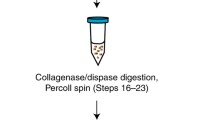Abstract
The integrity of the blood-brain barrier (BBB) is essential for the normal functioning of the central nervous system (CNS). Isolated brain capillaries are essential for analyzing changes in protein and gene expression at the BBB under physiological and pathological conditions. The standard methods for isolating brain capillaries require the use of at least one or more mouse brains in order to obtain sufficient quantity and purity of brain capillaries. Here, we describe an optimized protocol for isolating and purifying capillaries from tiny amounts of mouse cerebral cortex using manual homogenization, density gradient centrifugation, and filtration while preserving the structural integrity and functional activity of microvessel fragments. Western blotting showed that proteins expressed at the BBB were enriched in mouse brain capillaries isolated by the optimized method compared to cerebral cortex protein homogenates. This approach can be used for the analysis of a variety of rare mouse genetic models and can also help the investigators to understand regional differences in susceptibility to pathological phenomena such as ischemia and traumatic brain injury. This will allow the investigators to better understand the physiology and pathology of the BBB.
Access this chapter
Tax calculation will be finalised at checkout
Purchases are for personal use only
Similar content being viewed by others
References
Abbott NJ, Patabendige AAK, Dolman DEM et al (2010) Structure and function of the blood–brain barrier. Neurobiol Dis 37:13–25. https://doi.org/10.1016/j.nbd.2009.07.030
Abbott NJ, Friedman A (2012) Overview and introduction: the blood-brain barrier in health and disease. Epilepsia 53:1–6. https://doi.org/10.1111/j.1528-1167.2012.03696.x
Obermeier B, Daneman R, Ransohoff RM (2013) Development, maintenance, and disruption of the blood-brain barrier. Nat Med 19:1584–1596. https://doi.org/10.1038/nm.3407
Daneman R, Prat A (2015) The blood–brain barrier. Cold Spring Harb Perspect Biol 7:a020412. https://doi.org/10.1101/cshperspect.a020412
Furtado D, Björnmalm M, Ayton S et al (2018) Overcoming the blood–brain barrier: the role of nanomaterials in treating neurological diseases. Adv Mater 30:1801362. https://doi.org/10.1002/adma.201801362
Nation DA, Sweeney MD, Montagne A et al (2019) Blood–brain barrier breakdown is an early biomarker of human cognitive dysfunction. Nat Med 25:270–276. https://doi.org/10.1038/s41591-018-0297-y
Lan G, Wang P, Chan RB et al (2022) Astrocytic VEGFA: an essential mediator in blood–brain-barrier disruption in Parkinson’s disease. Glia 70:337–353. https://doi.org/10.1002/glia.24109
Kassner A, Merali Z (2015) Assessment of blood–brain barrier disruption in stroke. Stroke 46:3310–3315. https://doi.org/10.1161/strokeaha.115.008861
Ortiz GG, Pacheco-Moisés FP, Macías-Islas MÁ et al (2014) Role of the blood–brain barrier in multiple sclerosis. Arch Med Res 45:687–697. https://doi.org/10.1016/j.arcmed.2014.11.013
Alluri H, Wiggins-Dohlvik K, Davis ML et al (2015) Blood–brain barrier dysfunction following traumatic brain injury. Metab Brain Dis 30:1093–1104. https://doi.org/10.1007/s11011-015-9651-7
Gendosz de Carrillo D, Student S, Bula D et al (2023) The protective effect of low-dose minocycline on brain microvascular ultrastructure in a rodent model of subarachnoid hemorrhage. Histochem Cell Biol 159:91–114. https://doi.org/10.1007/s00418-022-02150-9
Helms HC, Abbott NJ, Burek M et al (2016) In vitro models of the blood–brain barrier: an overview of commonly used brain endothelial cell culture models and guidelines for their use. J Cereb Blood Flow Metab 36:862–890. https://doi.org/10.1177/0271678x16630991
Wu Z, Hofman FM, Zlokovic BV (2003) A simple method for isolation and characterization of mouse brain microvascular endothelial cells. J Neurosci Methods 130:53–63. https://doi.org/10.1016/s0165-0270(03)00206-1
Munikoti VV, Hoang-Minh LB, Ormerod BK (2012) Enzymatic digestion improves the purity of harvested cerebral microvessels. J Neurosci Methods 207:80–85. https://doi.org/10.1016/j.jneumeth.2012.03.011
Goldstein GW, Wolinsky JS, Csejtey J, Diamond I (1975) Isolation of metabolically active capillaries from rat brain. J Neurochem 25:715–717. https://doi.org/10.1111/j.1471-4159.1975.tb04395.x
Hartz AMS, Schulz JA, Sokola BS et al (2018) Isolation of cerebral capillaries from fresh human brain tissue. J Vis Exp. https://doi.org/10.3791/57346
Takakura Y, Audus KL, Borchardt RT (1991) Blood—brain barrier: transport studies in isolated brain capillaries and in cultured brain endothelial cells:137–165. https://doi.org/10.1016/s1054-3589(08)60034-4
Dilling C, Roewer N, Förster CY, Burek M (2017) Multiple protocadherins are expressed in brain microvascular endothelial cells and might play a role in tight junction protein regulation. J Cereb Blood Flow Metab 37:3391–3400. https://doi.org/10.1177/0271678x16688706
Burek M, König A, Lang M et al (2019) Hypoxia-induced MicroRNA-212/132 alter blood-brain barrier integrity through inhibition of tight junction-associated proteins in human and mouse brain microvascular endothelial cells. Transl Stroke Res 10:672–683. https://doi.org/10.1007/s12975-018-0683-2
Burek M, Burmester S, Salvador E et al (2020) Kidney ischemia/reperfusion injury induces changes in the drug transporter expression at the blood–brain barrier in vivo and in vitro. Front Physiol 11. https://doi.org/10.3389/fphys.2020.569881
Lee Y-K, Uchida H, Smith H et al (2019) The isolation and molecular characterization of cerebral microvessels. Nat Protoc 14:3059–3081. https://doi.org/10.1038/s41596-019-0212-0
Silbergeld DL, Ali-Osman F (1991) Isolation and characterization of microvessels from normal brain and brain tumors. J Neuro-Oncol 11:49–55. https://doi.org/10.1007/bf00166997
Ogata S, Ito S, Masuda T, Ohtsuki S (2021) Efficient isolation of brain capillary from a single frozen mouse brain for protein expression analysis. J Cereb Blood Flow Metab 41:1026–1038. https://doi.org/10.1177/0271678x20941449
Paraiso HC, Wang X, Kuo P-C et al (2020) Isolation of mouse cerebral microvasculature for molecular and single-cell analysis. Front Cell Neurosci 14. https://doi.org/10.3389/fncel.2020.00084
Acknowledgments
We thank Elisabeth Wilken for her excellent technical assistance.
Author information
Authors and Affiliations
Corresponding author
Editor information
Editors and Affiliations
Rights and permissions
Copyright information
© 2024 The Author(s), under exclusive license to Springer Science+Business Media, LLC, part of Springer Nature
About this protocol
Cite this protocol
Mi, J., Sun, A., Härtel, L., Dilling, C., Meybohm, P., Burek, M. (2024). Isolation of Capillaries from Small Amounts of Mouse Brain Tissue. In: Ray, S.K. (eds) Neuroprotection. Methods in Molecular Biology, vol 2761. Humana, New York, NY. https://doi.org/10.1007/978-1-0716-3662-6_2
Download citation
DOI: https://doi.org/10.1007/978-1-0716-3662-6_2
Published:
Publisher Name: Humana, New York, NY
Print ISBN: 978-1-0716-3661-9
Online ISBN: 978-1-0716-3662-6
eBook Packages: Springer Protocols




